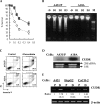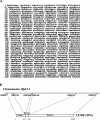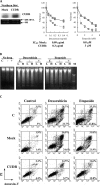Induction of drug resistance and transformation in human cancer cells by the noncoding RNA CUDR
- PMID: 17416635
- PMCID: PMC1869035
- DOI: 10.1261/rna.359007
Induction of drug resistance and transformation in human cancer cells by the noncoding RNA CUDR
Abstract
Refractory to apoptosis induced by anticancer drugs is one of the major causes of drug resistance in human cancers. The involvement of noncoding RNA (ncRNA) in cancer cell drug resistance has not yet been reported. By using the technique of RT-PCR-based differential display, a novel gene, cancer up-regulated drug resistant (CUDR) gene, was found to be overexpressed in a doxorubicin-resistant subline of human squamous carcinoma A431 and A10A cells, which were also more resistant to drug-induced apoptosis. The full-length CUDR mRNA transcript is approximately 2.2 kb as detected by Northern blot analysis and has no sequence homology with other genes identified so far. Interestingly, no distinct open reading frame was found throughout the CUDR cDNA sequence, and no recombinant protein was detected from in vitro translation or from a protein lysate of human cancer cells after CUDR transfection. Therefore, CUDR is likely to exert its function as a noncoding RNA. Stable transfection with the CUDR gene was found to induce resistance to doxorubicin and etoposide as well as drug-induced apoptosis in A431 cells. By Western blot analysis, down-regulations of caspase 3 were observed in CUDR transfectants. On the other hand, overexpression of CUDR promoted anchorage-independent growth in A431 cells. Results from the present study suggest that CUDR may likely regulate the drug sensitivity and promote cellular transformation at least through caspase 3-dependent apoptosis.
Figures





Similar articles
-
Long non-coding RNA UCA1a(CUDR) promotes proliferation and tumorigenesis of bladder cancer.Int J Oncol. 2012 Jul;41(1):276-84. doi: 10.3892/ijo.2012.1443. Epub 2012 Apr 20. Int J Oncol. 2012. PMID: 22576688
-
Riboregulator H19 induction of MDR1-associated drug resistance in human hepatocellular carcinoma cells.Oncogene. 2007 Jul 19;26(33):4877-81. doi: 10.1038/sj.onc.1210266. Epub 2007 Feb 5. Oncogene. 2007. PMID: 17297456
-
Long Noncoding RNA CUDR Regulates HULC and β-Catenin to Govern Human Liver Stem Cell Malignant Differentiation.Mol Ther. 2015 Dec;23(12):1843-53. doi: 10.1038/mt.2015.166. Epub 2015 Sep 8. Mol Ther. 2015. PMID: 26347501 Free PMC article.
-
The role of noncoding RNAs and sirtuins in cancer drug resistance.Eur J Pharmacol. 2020 Jun 15;877:173094. doi: 10.1016/j.ejphar.2020.173094. Epub 2020 Mar 31. Eur J Pharmacol. 2020. PMID: 32243871 Review.
-
Molecular tumor clocks to study the evolution of drug resistance.Mol Pharm. 2011 Dec 5;8(6):2050-4. doi: 10.1021/mp200256n. Epub 2011 Jul 12. Mol Pharm. 2011. PMID: 21732670 Free PMC article. Review.
Cited by
-
Targeting long non-coding RNA to therapeutically upregulate gene expression.Nat Rev Drug Discov. 2013 Jun;12(6):433-46. doi: 10.1038/nrd4018. Nat Rev Drug Discov. 2013. PMID: 23722346 Review.
-
Quantitative assessment of short amplicons in FFPE-derived long-chain RNA.Sci Rep. 2014 Nov 28;4:7246. doi: 10.1038/srep07246. Sci Rep. 2014. PMID: 25430878 Free PMC article.
-
Noncoding RNA as therapeutic targets for hepatocellular carcinoma.Semin Liver Dis. 2015 Feb;35(1):63-74. doi: 10.1055/s-0034-1397350. Epub 2015 Jan 29. Semin Liver Dis. 2015. PMID: 25632936 Free PMC article. Review.
-
Mechanistic Roles of Noncoding RNAs in Lung Cancer Biology and Their Clinical Implications.Genet Res Int. 2012;2012:737416. doi: 10.1155/2012/737416. Epub 2012 Jul 18. Genet Res Int. 2012. PMID: 22852089 Free PMC article.
-
The growth arrest-specific transcript 5 (GAS5): a pivotal tumor suppressor long noncoding RNA in human cancers.Tumour Biol. 2016 Feb;37(2):1437-44. doi: 10.1007/s13277-015-4521-9. Epub 2015 Dec 3. Tumour Biol. 2016. PMID: 26634743 Review.
References
-
- Cole, S.P., Deeley, R.G. Multidrug resistance mediated by the ATP-binding cassette transporter protein MRP. Bioessays. 1995;20:931–940. - PubMed
-
- Devarajan, E., Sahin, A.A., Chen, J.S., Krishnamurthy, R.R., Aggarwal, N., Brun, A.M., Sapino, A., Zhang, F., Sharma, D., Yang, X.H., et al. Down-regulation of caspase 3 in breast cancer: A possible mechanism for chemoresistance. Oncogene. 2002;21:8843–8851. - PubMed
-
- Eddy, S.R. Noncoding RNA genes and the modern RNA world. For. Genet. 2001;2:919–929. - PubMed
-
- Fire, A., Xu, S., Montomery, M.K., Kostas, S.A., Driver, S.E., Mello, C.C. Potent and specific genetic interference by double-stranded RNA in Caenorhabditis elegans . Nature. 1998;391:806–811. - PubMed
Publication types
MeSH terms
Substances
LinkOut - more resources
Full Text Sources
Research Materials
